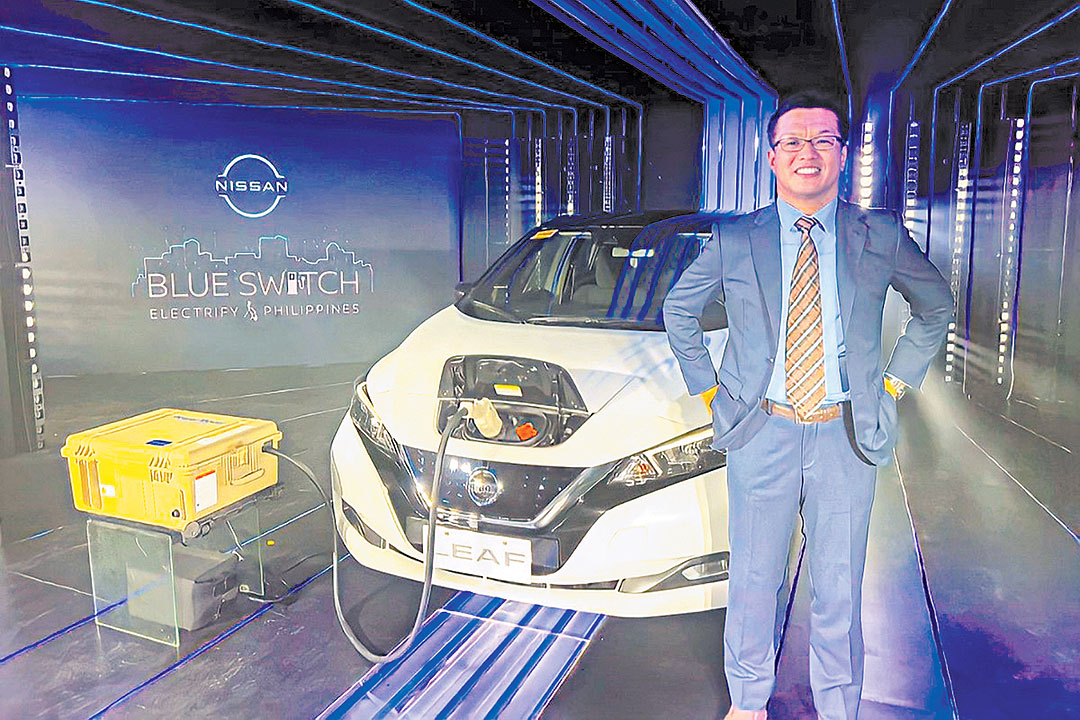
Wayfarer
By Angel Rivero

I’VE BEEN part of Nissan’s Philippine contingent to the biennial Tokyo Motor Show held in Japan over the last three times the event materialized. It was during these times that we had extremely immersive experiences that had everything to do with Nissan’s innovative Intelligent Mobility, electric and e-power vehicles, and other upcoming products. I remember asking myself when the right time might come when many of these modern technologies could finally — even just gradually — be adopted in the Philippine context. Fast-forward to two (going on three) years into the pandemic, I am actually pleased to see some baby steps towards the electric mobility route in our country, strongly led by the efforts of Nissan Philippines. Yay!
And so in yet another one of its strategic moves in the country, Nissan Philippines recently launched what it calls its “Blue Switch Initiative.” This marks the next phase of Nissan’s massive electrification plans which are, in turn, built on the premise of “Nissan Ambition 2030.”
The concept of Nissan Ambition 2030 was officially launched in Yokohama, Japan sometime late last year — as an important response to critical environmental, societal, and customer needs. And the core ambition of this project is to further transform Nissan into a sustainable company that drives toward a cleaner, safer, and more inclusive world.
Those are really large concepts to grasp — larger than life, to be honest. But if you will care to indulge the company, it says that the goal is to go carbon-neutral across the life cycle of its product offerings by fiscal year 2050. While doing so, it seeks to empower society in order to enable it to build a smart ecosystem with integrated mobility. For that, we’d need electric vehicles. So, the introduction and popularization of such in the Philippines is where we’re at.
Indeed, Nissan has democratized mass-market electric vehicles with its long-time introduction of the Leaf EV, which is now also available in the Philippines as of its local launch last year. And since vehicle electrification appears to now be at the core of the company’s long-term strategy, the company has already pledged investments of two trillion yen over the next five years in order to accelerate the development of its EV lineup and other tech innovations.
Nissan Chief Operating Officer Ashwani Gupta shares, “With our new ambition, we continue to take the lead in accelerating the natural shift to EVs by creating customer pull through an attractive proposition by driving excitement, enabling adoption and creating a cleaner world.”
Thus, the activation of Nissan’s Blue Switch Initiative in the Philippines is a major local milestone in achieving such an end. In Japan, the initiative zoned in on partnering with the government and private stakeholders to encourage the use of EVs for addressing issues such as energy management, eco-tourism and disaster response. Here in the Philippines, Nissan already managed to demonstrate the Leaf’s strengths when it comes to disaster response. The company used the Leaf EV alongside power mover units to help feed electrical power into some affected parts of Cebu, after the destructive effects of Typhoon Odette. If you will remember, Nissan’s vehicle-to-load (V2L) technology enables the energy stored in an electric vehicle’s battery (in this case, the Nissan Leaf’s) to be transferred into a grid. This technology may be used either to simply lower the cost of electricity of a certain household (if peak rates are applied by the electricity provider), or to power places that are completely without electricity due to natural calamities.
The Nissan Leaf was also toured in our precious Boracay Island, as part of the Nissan Philippines “Safe Trips” campaign and also to advocate for eco-tourism in this highly visited location. It is clear that the beautiful island has much to benefit from the use of EVs as people’s main mode of transportation — starting with the obvious: less noise pollution and cleaner air.
Nissan Philippines President and Managing Director Atsushi Najima explains that, “When we integrate EV technology into society, we can unify people, systems, and our goals as a nation. EVs can boost tourism, protect the environment, help us respond to emergencies faster, and help enrich the lives of many people. We are looking to turn this dream into reality this 2022, and we can do this by working together.”
I can’t wait to witness all the other innovations I’ve seen from Nissan’s Intelligent Mobility suite to trickle down as practical applications in our country. With ever more support from the national government, what promising heights we can achieve!